译林版九年级英语下册第二单元全套教学案设计
- 格式:docx
- 大小:2.14 MB
- 文档页数:26
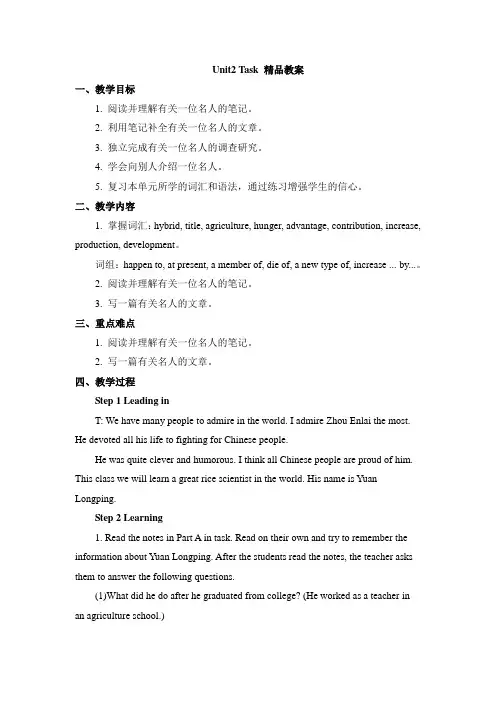
Unit2 Task 精品教案一、教学目标1. 阅读并理解有关一位名人的笔记。
2. 利用笔记补全有关一位名人的文章。
3. 独立完成有关一位名人的调查研究。
4. 学会向别人介绍一位名人。
5. 复习本单元所学的词汇和语法,通过练习增强学生的信心。
二、教学内容1. 掌握词汇:hybrid, title, agriculture, hunger, advantage, contribution, increase, production, development。
词组:happen to, at present, a member of, die of, a new type of, increase ... by...。
2. 阅读并理解有关一位名人的笔记。
3. 写一篇有关名人的文章。
三、重点难点1. 阅读并理解有关一位名人的笔记。
2. 写一篇有关名人的文章。
四、教学过程Step 1 Leading inT: We have many people to admire in the world. I admire Zhou Enlai the most. He devoted all his life to fighting for Chinese people.He was quite clever and humorous. I think all Chinese people are proud of him. This class we will learn a great rice scientist in the world. His name is Yuan Longping.Step 2 Learning1. Read the notes in Part A in task. Read on their own and try to remember the information about Yuan Longping. After the students read the notes, the teacher asks them to answer the following questions.(1)What did he do after he graduated from college? (He worked as a teacher in an agriculture school.)(2)What is he famous for? (He developed a new type of hybrid rice plant, which produced 20% more rice per unit than other common kinds.)(3)Why does Amy admire him? (Because he has spent all his life on the research and development of better rice plants.)2. Speech competition.Divide the class into groups of four, and ask one student from each group to make a speech about Yuan Longping in front of the class. See which group can give the most information that is mentioned in Part A in task.3. Ask students to finish Amy’s script about Yuan Longping in Part B in Task in pairs, and discuss what he experienced between 1964 and 1979. Then check the answers with the whole class.4. Retelling.In order to do this task well, we had better have students read the script again and again until they have become very familiar with it. Only after that, can we ask some students to retell the article.Step 3 Writing1. Summarize how to organize the order to write an article.2. Choose one great person in China or in the world to write down their experiences.3. Then ask three or four students to read out their articles and check it.Step 4 Homework1. Continue to write the article unfinished.2. Finish some exercises in the exercise book.五、板书设计。
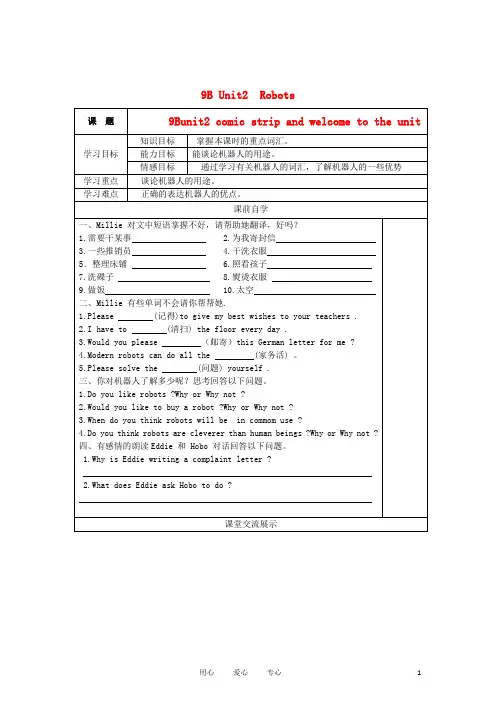
9B Unit2 Robots9BUnit2 Robots参考答案comic strip and welcome to the unit二、用所给词的适当形式填空。
zier2. explorer3.well4.children5.dishes三、根据提示,完成下列句子。
1.explore dangerous places2.nood more3.do post for4.what do 5why did 6.listen to explain.Reading (1)一、根据句意和所给的中文写出句中所缺的词。
Saleman ironed laundry virus dustbin knock mess trouble一、选用所给词组的适当形式填空.1. messing2. own3. in order to4. were made5. rice cooker Reading (2)一、根据句意及中文写出适当的单词。
1.owns2.virus3.dustbin4.mess5. dirty二、完成下列句子1.I don't know when the machine caught a virus .2.By the way ,who is the first perdon to own a rabot ?3.The machine is washing is bought by me yasterday .4.I bought a robot in order to have more time .Vocaburay二、选用所给词组的适当形式填空.1.arms2. hands3.speakers4. wheels5.camera6. batterriesGrammarA一、选择正确的答案。
1.B2.C3.D4. A5.B ;6.A7.B8.B9.C 10.D二、用所给出的疑问词完成下列句子1.where2.what3.who4.which5.when6.how7.what8.why9.what 10.why Grammar B & C一、完成下列句子1. in order to2. as a result3.need in order to4.because of5.to in order to二.用in order to 和as a result完成下列句子。
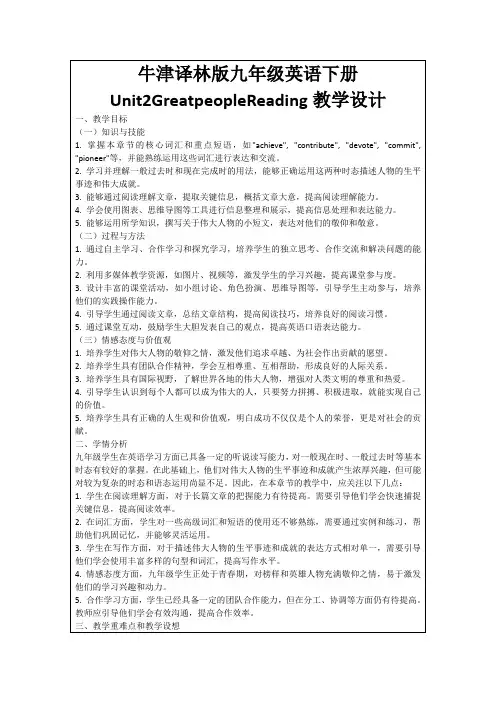
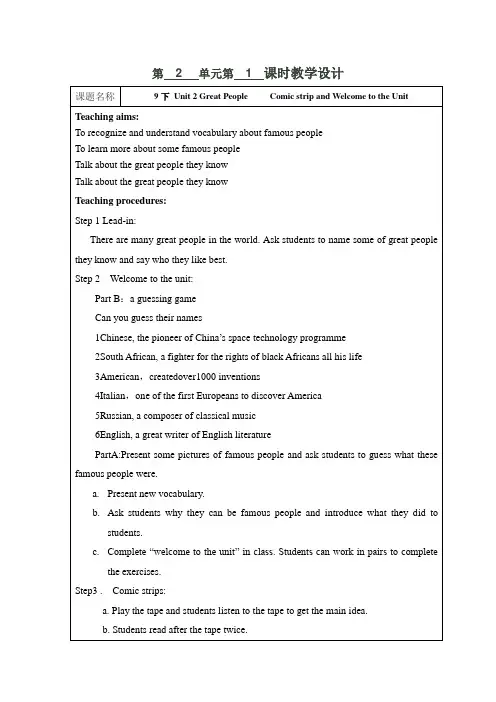

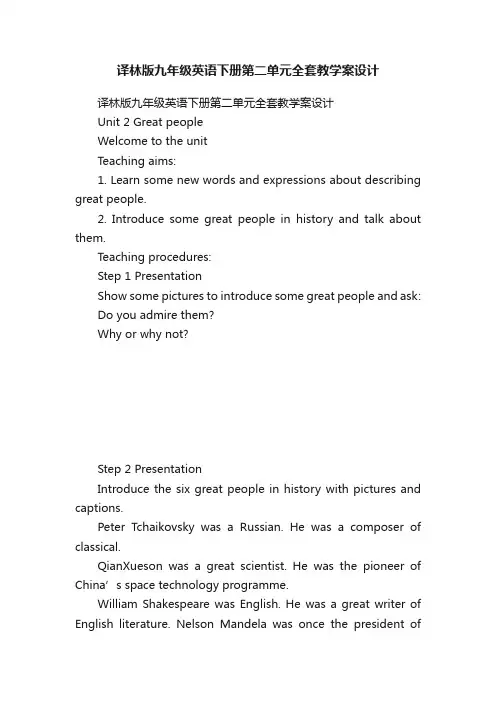
译林版九年级英语下册第二单元全套教学案设计译林版九年级英语下册第二单元全套教学案设计Unit 2 Great peopleWelcome to the unitTeaching aims:1. Learn some new words and expressions about describing great people.2. Introduce some great people in history and talk about them.Teaching procedures:Step 1 PresentationShow some pictures to introduce some great people and ask: Do you admire them?Why or why not?Step 2 PresentationIntroduce the six great people in history with pictures and captions.Peter Tchaikovsky was a Russian. He was a composer of classical.QianXueson was a great scientist. He was the pioneer of China’s space technology programme.William Shakespeare was English. He was a great writer of English literature. Nelson Mandela was once the president ofSouth Africa. He was a fighter for the rights of black Africans all his life.Thomas Edison was a great inventor who created over 1,000 inventions.Christopher Columbus was a great explorer. He was one of the first Europeans to discover America.Step 3 Write and matchComplete Part A& B on page 21.Mr Wu is showing the Class 1, Grade 9 students the pictures of some famous people. Help the students write the correct word under each picture.Keys: inventor explorer writer president scientist composer Mr Wu is telling the students about the famous people in Part A. Help the students match the names on the left with the correct information on the right.1. Christopher Columbus2. William Shakespeare3. QianXueson4. Thomas Edison5. Nelson Mandela6. Peter Tchaikovskya. Chinese, the pioneer of China’s space technology programmeb. South African, a fighter for the rights of black Africans allc. American, created over 1,000 inventionsd. Italian, one of the first Europeans to discover Americae. Russian, a composer of classical musicf. English, a great writer of English literatureKeys: 1-d 2-f 3-a 4-c 5-b 6-eStep 4 Listen and answerI. Listen to the conversation between Hobo and Eddie and answer the following questions:1. What are they talking about?2. Who does Eddie think is the greatest person in history?3. Why does Eddie think so?Keys: 1. They are talking about who is the greatest person in history.2. Paul Yum.3. Because he thinks Paul Yum invented his favourite food.II. Read and act out the conversation.Step 5 Explanation1. I’ve never heard of him.hear of … 听说hear 听见,听到e.g. 你能听到她在隔壁房间唱歌吗?Can you hear her singing in the next room?你以前听说过这首歌吗?Have you heard of this song before?2. He invented my favourite food.invent vt.发明inventor n. 发明家,发明者invention n.发明物,创意e.g. 托马斯·爱迪生,一位伟大的发明家,发明了1000多种发明Thomas Edison, a great inventor, invented over 1,000 inventions.3. Who do you think is the greatest person in history, Eddie?句中的do you think是该疑问句中的插入部分。
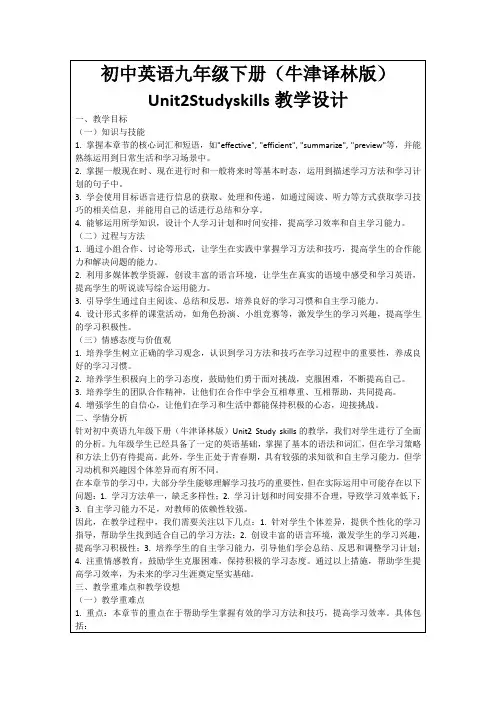
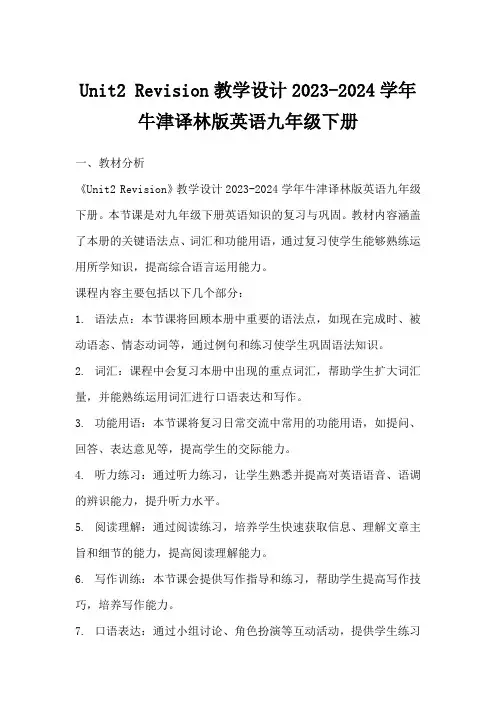
Unit2 Revision教学设计2023-2024学年牛津译林版英语九年级下册一、教材分析《Unit2 Revision》教学设计2023-2024学年牛津译林版英语九年级下册。
本节课是对九年级下册英语知识的复习与巩固。
教材内容涵盖了本册的关键语法点、词汇和功能用语,通过复习使学生能够熟练运用所学知识,提高综合语言运用能力。
课程内容主要包括以下几个部分:1. 语法点:本节课将回顾本册中重要的语法点,如现在完成时、被动语态、情态动词等,通过例句和练习使学生巩固语法知识。
2. 词汇:课程中会复习本册中出现的重点词汇,帮助学生扩大词汇量,并能熟练运用词汇进行口语表达和写作。
3. 功能用语:本节课将复习日常交流中常用的功能用语,如提问、回答、表达意见等,提高学生的交际能力。
4. 听力练习:通过听力练习,让学生熟悉并提高对英语语音、语调的辨识能力,提升听力水平。
5. 阅读理解:通过阅读练习,培养学生快速获取信息、理解文章主旨和细节的能力,提高阅读理解能力。
6. 写作训练:本节课会提供写作指导和练习,帮助学生提高写作技巧,培养写作能力。
7. 口语表达:通过小组讨论、角色扮演等互动活动,提供学生练习口语表达的机会,提高口语交流能力。
本节课的设计旨在帮助学生全面复习和巩固九年级下册的知识,提高学生的英语综合运用能力,为升入高中阶段打下坚实的基础。
二、核心素养目标本节课旨在培养学生的英语学科核心素养,包括语言能力、文化意识、思维品质和学习能力。
1. 语言能力:通过复习和练习,提高学生的听、说、读、写四项基本语言技能,使他们在各种情境中能够熟练、准确地运用所学英语知识进行交流。
2. 文化意识:通过学习英语,使学生了解和尊重英语国家的文化,培养他们的跨文化交际意识,提高他们在国际交流中的文化适应能力。
3. 思维品质:通过分析、讨论等教学活动,培养学生的逻辑思维、创新思维和批判性思维,使他们能够独立思考,善于提出问题,敢于发表自己的见解。
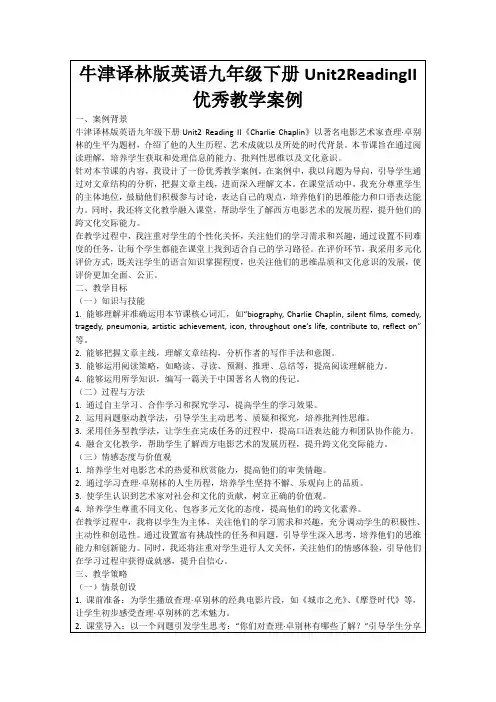
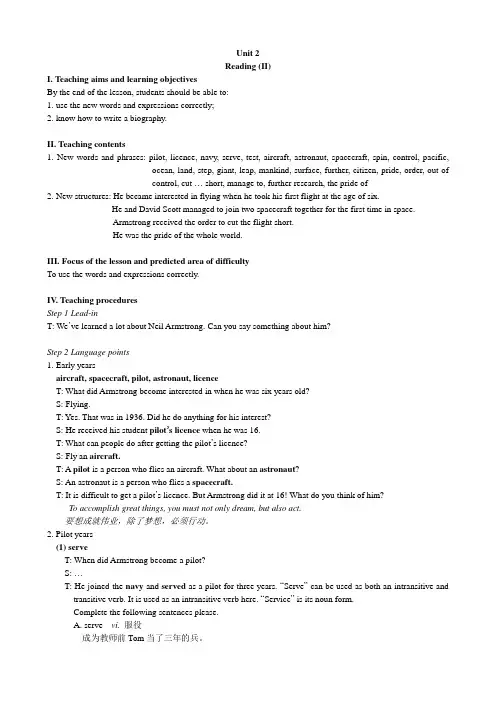
Unit 2Reading (II)I. Teaching aims and learning objectivesBy the end of the lesson, students should be able to:1. use the new words and expressions correctly;2. know how to write a biography.II. Teaching contents1. New words and phrases: pilot, licence, navy, serve, test, aircraft, astronaut, spacecraft, spin, control, pacific,ocean, land, step, giant, leap, mankind, surface, further, citizen, pride, order, out ofcontrol, cut … short, manage to, further research, the pride of2. New structures: He became interested in flying when he took his first flight at the age of six.He and David Scott managed to join two spacecraft together for the first time in space.Armstrong received the order to cut the flight short.He was the pride of the whole world.III. Focus of the lesson and predicted area of difficultyTo use the words and expressions correctly.IV. Teaching proceduresStep 1 Lead-inT: We’ve learned a lot about Neil Armstrong. Can you say something about him?Step 2 Language points1. Early yearsaircraft, spacecraft, pilot, astronaut, licenceT: What did Armstrong become interested in when he was six years old?S: Flying.T: Yes. That was in 1936. Did he do anything for his interest?S: He received his student pilot’s licence when he was 16.T: What can people do after getting the pilot’s licence?S: Fly an aircraft.T: A pilot is a person who flies an aircraft. What about an astronaut?S: An astronaut is a person who flies a spacecraft.T: It is difficult to get a pilot’s licence. But Armstrong did it at 16! What do you think of him?To accomplish great things, you must not only dream, but also act.要想成就伟业,除了梦想,必须行动。
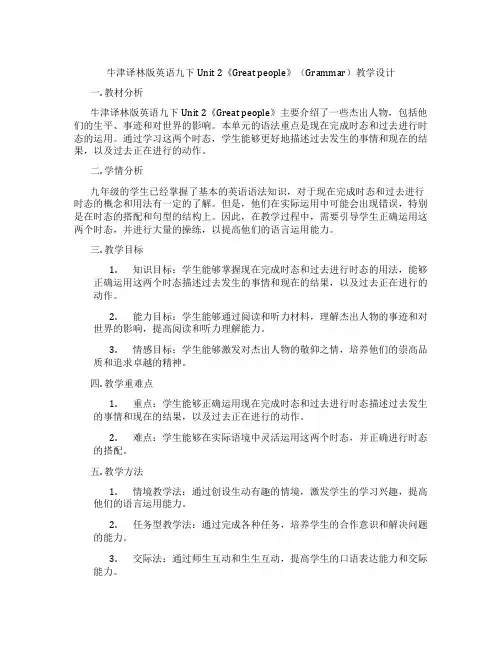
牛津译林版英语九下Unit 2《Great people》(Grammar)教学设计一. 教材分析牛津译林版英语九下Unit 2《Great people》主要介绍了一些杰出人物,包括他们的生平、事迹和对世界的影响。
本单元的语法重点是现在完成时态和过去进行时态的运用。
通过学习这两个时态,学生能够更好地描述过去发生的事情和现在的结果,以及过去正在进行的动作。
二. 学情分析九年级的学生已经掌握了基本的英语语法知识,对于现在完成时态和过去进行时态的概念和用法有一定的了解。
但是,他们在实际运用中可能会出现错误,特别是在时态的搭配和句型的结构上。
因此,在教学过程中,需要引导学生正确运用这两个时态,并进行大量的操练,以提高他们的语言运用能力。
三. 教学目标1.知识目标:学生能够掌握现在完成时态和过去进行时态的用法,能够正确运用这两个时态描述过去发生的事情和现在的结果,以及过去正在进行的动作。
2.能力目标:学生能够通过阅读和听力材料,理解杰出人物的事迹和对世界的影响,提高阅读和听力理解能力。
3.情感目标:学生能够激发对杰出人物的敬仰之情,培养他们的崇高品质和追求卓越的精神。
四. 教学重难点1.重点:学生能够正确运用现在完成时态和过去进行时态描述过去发生的事情和现在的结果,以及过去正在进行的动作。
2.难点:学生能够在实际语境中灵活运用这两个时态,并正确进行时态的搭配。
五. 教学方法1.情境教学法:通过创设生动有趣的情境,激发学生的学习兴趣,提高他们的语言运用能力。
2.任务型教学法:通过完成各种任务,培养学生的合作意识和解决问题的能力。
3.交际法:通过师生互动和生生互动,提高学生的口语表达能力和交际能力。
六. 教学准备1.教师准备:提前准备好相关的教学材料,如PPT、听力材料、阅读材料等。
2.学生准备:学生提前预习课文,了解本节课的主要内容。
七. 教学过程1.导入(5分钟)教师通过展示一些杰出人物的照片,引导学生谈论他们的事迹和对世界的影响,激发学生的学习兴趣。
《英语》(九年级下册)Unit 2 Great peopleComic strip and Welcome to the unitI. Teaching aims and learning objectivesBy the end of the lesson, students should be able to:1. use new words and phrases correctly;2. know about some famous people in history and learn something from them.II. Teaching contents1. New words and phrases: inventor, invent, fighter, invention, explorer, European, Russian, South African, Italian2. New structures: Who do you think is the greatest person in history?III. Focus of the lesson and predicted area of difficultyUse the new words, phrases and structures in particular situations correctly.IV. Teaching proceduresWelcome to the unitStep 1 Free talkT: Great people made great contributions (贡献) to society and have changed the way we live.Do you know any great people in history?Where was he/she from?What did he/she do?【设计意图:通过头脑风暴,让学生说出自己知道的历史伟人的名字,并简要介绍,迅速导入新课。
Unit2 Integrated skill and Study skills 精品教案一、教学目标1. 学会从人物简介中提取信息。
2. 补全笔记。
3. 谈论名人以及我们钦佩他们的原因。
二、教学内容词汇:Japanese, state。
词组:mathematics, scientist,radium, laboratory, professor, discovery, unknown, widely。
句型:Who do you think is the greatest person in history?It was brave of him to go to a place that was unknown to humans at that time.She also pushed for the use of X-ray machines, which are now widely used in hospitals.三、重点难点1. 通过阅读和听录音完成笔记。
2. 谈论名人以及我们钦佩他们的原因。
四、教学过程Step 1 PresentationAsk students to present what they have collected from the Internet about Marie Curie.T: Boys and girls, yesterday I told you to find out some information about the great woman, Marie Curie. I believe you have known her more or less. (Ask them to present their information about Marie Curie.)Now I will show a profile about her to you. Tell me what you can know from the profile. (Have students discuss it in pairs. Five minutes later ask them to show the class his or her opinion.)Step 2 Learning the Part A1. Read and do Part Al.Read the introduction about Marie Curie. From the reading, even the less able students can get some elementary information on Marie Curie just like the date ofbirth, the place of birth, her husband and so on. After that, ask them to fill in the blanks using the information they got from the short passage.2. Listen and finish Part Al.Play the tape for students to listen to. Students should listen carefully to complete the rest of Milie’s notes. Of course meanwhile they should check the answers they have got in the last step. The teacher can let students listen to the tape twice.3. DiscussionDivide students into eight groups. Encourage them to ask and answer questions about Marie Curie to each other. They can raise some questions according to the notes.e.g. When and where was she born?What did she study in college?Who married her?In 1898, what did the couple discover?How many Nobel Prizes did she get?In a word, the more, the better. Only in that way can we let students become more and more familiar with Marie Curie. It is also good for students to complete the biographical passage in Part A3.4. PracticeOn the basis of the steps above, ask students to complete the biographical passage in Part A3 according to all the information they have got Now it’s easy for students to do this task. But don’t forget to ask them to read aloud the passage again and again. This is good for later writing.Step 3 Learn the Part B1. Listen to the recorder and answer the following questions.(1)Who does Simon admire most?(2)What did Marie Curie discover?2. Work in pairs to practice the dialogue.3. Act it out.4. Make up another dialogue like the model.Step 4 Learning “Study skills”The teacher give students some formal English and informal English such as “hello, hi, NBA, Dec. we’ll,he’d” or “lots of love, yours truly, cheers, have a big mouth, all wet”. Then tell the students they are widely used in our spoken English and written English. Next, the students give some examples.The students with the teacher finish checking the language of the letter to J. K. Rowling.Step 5 Homework1. Finish the exercises in the exercise book.2. Preview “Task” Part.五、板书设计Unit 2 Integrated skill and Study skills1. V ocabulary:mathematics, Frenchman, couple, unknown, X-ray, marry a Frenchman, get married, for the discovery of, be unknown to2. Sentences :Who do you think is the greatest person that has ever lived?I admire him the most.。
Unit 2 Great peopleStudy skillsI. Teaching aims and learning objectivesBy the end of the lesson, students should be able to:1. understand differences between formal and informal language;2. use formal and informal language correctly.II.Focus of the lesson and predicted area of difficultyTo understand and use formal and informal language in a correct way.III. Teaching proceduresStep 1 Lead-in1. A letter to a friendT: When we speak or write to different people, do we use the same style of text?Please read a thank-you letter from Sandy.Hi, honey!Many thanks to you for the dinner yesterday. Yummy! I should say you’re really a top cook. I enjoyed all the food, esp. the fish soup. It’s my favorite!…It is raining cats and dogs now. But I feel so nice when thinking of your dinner. Ha-ha!Hope to get together again!Lots of love,SandyT: Who do you think Sandy is writing to, a friend or an unfamiliar person or a teacher?T: When we write or speak to a friend, we use informal language.2. A letter to an unfamiliar personDear Mrs Green,I am writing to show my sincere thanks for your hospitality during my stay at your school this April. I reallyappreciate your help, especially your encouragement with my work. I believe what I learned at your school will certainly help me improve my teaching at home.Long distance separates no bosom friends. I hope …Faithfully yours,SandyT: What about this letter? Who is Sandy writing to?T: We use formal language with unfamiliar people or teachers.Step 2 Presentation1. Different greetings and endingsT: What are the differences between formal and informal language? Can you find it?T: We use different greetings and different endings.(1) Different greetingsT: Well, can you classify these greetings? Which are formal? Which are informal?(2) Different endingsT: And when we write to others, we use the endings differently.2. Using idiomsT: What other differences can you find?We can use idioms like “It rains cats and dogs.” in informal language. Well, what are idioms?T: Idioms are phrases and sentences that do not mean exactly what they say. Even if you know the meaning of each word you see or hear, you may not understand the idiom because you don’t understand the culture behind it, e.g. It rains cats and dogs.T: Usually we use idioms in spoken English. They are informal. What idioms do you know?T: Do you know these idioms? What do they mean?T: Language is wonderful. Read more, and you will learn more.3. Using contractions and abbreviationsT: What about contractions and abbreviations?T: Contractions are short forms of words when apostrophe replace letters, e.g. we’ll, she’s, can’t.Abbreviations use only the first letters of a name or phrase, or leave out letters to shorten a word, e.g. UK, Dr. They are both used in informal language.T: What other contractions and abbreviations do you know? Work in groups.T: Perfect! Many hands make light work!Step 3 Practice1. Classify the expressionsT: Now can you classify the expressions correctly?T: So formal language is used for unfamiliar people or teachers while informal language is for friends and parents.2. Improve Kitty’s letterT: Kitty is writing to J. K. Rowling, the British writer, to tell her something about Harry Potter.Please read her letter.T: Does Kitty need to improve her letter? Why?T: To Kitty, J. K. Rowling is an unfamiliar person.She shouldn’t (use informal greetings or endings.)She shouldn’t (use contractions or abbreviations.)She shouldn’t (use idioms.)She should sign her full name.T: Please rewrite Kitty’s letter.T: Good job! Read it by yourselves.Step 4 ProductionWriting a letter to the headmasterT: Work in groups. Write a letter to the headmaster and advise him to organize a school trip. Pay attention to your expressions. You can use the following expression as an example.IV. HomeworkWrite a letter to your headmaster to recommend yourself as chairperson of the Students’ Union.。
译林版九年级英语下册第二单元全套教学案设计Unit 2 Great peopleWelcome to the unitTeaching aims:1. Learn some new words and expressions about describing great people.2. Introduce some great people in history and talk about them.Teaching procedures:Step 1 PresentationShow some pictures to introduce some great people and ask:Do you admire them?Why or why not?Step 2 PresentationIntroduce the six great people in history with pictures and captions.Peter Tchaikovsky was a Russian. He was a composer of classical.QianXueson was a great scientist. He was the pioneer of China’s space technology programme.William Shakespeare was English. He was a great writer of English literature. Nelson Mandela was once the president of South Africa. He was a fighter for the rights of black Africans all his life.Thomas Edison was a great inventor who created over 1,000 inventions.Christopher Columbus was a great explorer. He was one of the first Europeans to discover America.Step 3 Write and matchComplete Part A& B on page 21.Mr Wu is showing the Class 1, Grade 9 students the pictures of some famous people. Help the students write the correct word under each picture.Keys: inventor explorer writer president scientist composerMr Wu is telling the students about the famous people in Part A. Help the students match the names on the left with the correct information on the right.1. Christopher Columbus2. William Shakespeare3. QianXueson4. Thomas Edison5. Nelson Mandela6. Peter Tchaikovskya. Chinese, the pioneer of China’s space technology programmeb. South African, a fighter for the rights of black Africans all his lifec. American, created over 1,000 inventionsd. Italian, one of the first Europeans to discover Americae. Russian, a composer of classical musicf. English, a great writer of English literatureKeys: 1-d 2-f 3-a 4-c 5-b 6-eStep 4 Listen and answerI. Listen to the conversation between Hobo and Eddie and answer the following questions:1. What are they talking about?2. Who does Eddie think is the greatest person in history?3. Why does Eddie think so?Keys: 1. They are talking about who is the greatest person in history.2. Paul Yum.3. Because he thinks Paul Yum invented his favourite food.II. Read and act out the conversation.Step 5 Explanation1. I’ve never heard of him.hear of … 听说hear 听见,听到e.g. 你能听到她在隔壁房间唱歌吗?Can you hear her singing in the next room?你以前听说过这首歌吗?Have you heard of this song before?2. He invented my favourite food.invent vt.发明inventor n. 发明家,发明者invention n.发明物,创意e.g. 托马斯·爱迪生,一位伟大的发明家,发明了1000多种发明物。
Thomas Edison, a great inventor, invented over 1,000 inventions.3. Who do you think is the greatest person in history, Eddie?句中的do you think是该疑问句中的插入部分。
Step 6 QuestionCan you think of any other person who is as famous as the persons mentioned in this lesson? Give some examples.Step 7 Exercise1.我认为周总理是历史上最伟大的人。
I think Premier Zhou _____________ _______________.2. 你有没有听说过一个叫Paul的电影演员?_____________________ an actor called Paul?3. 你知道谁发明了第一部照相机吗?Do you know __________________________?4. 曼德拉是一位终生为非洲黑人争取权利的斗士。
Mandela _____________________________________________.5. 贝多芬也是历史上最伟大的古典乐作曲家之一。
Beethoven ______________________________________________.6. 19 世纪时,在加利福尼亚发现了金子。
In the 19th century, _______________________________ in California.Keys:1. is the greatest person in history2. Have you ever heard of3. who invented the first camera4. was a fighter for the rights of black Africans all his life5. was also one of the greatest composers of classical music in history6. gold was discoveredHomework1. Recite the dialogue in the comic.2. Prepare for the next lesson.Reading ITeaching aims:1. Practise reading skills by reading the article about Neil Armstrong.2. Learn some expressions about introduce a great person.Teaching stepsStep 1 ReviewComplete the following sentences:1. Who do you think is the _______ person in history?2. I’ve never _______ _______ Paul Yum.3. Thomas Edison was an American ________ who _______________ more than 1,000 _________.4. Christopher Columbus was an ________ explorer, one of the first Europeans to _______ America.5. William Shakespeare was a great writer of English ___________.6. QianXueson was the _________ of China’s space technology programme.7. Nelson Mandela was a _______ for the rights of black Africans all his life.8. Peter Tchaikovsky was a __________ of ________ music.Keys: greatestheard ofinventor created /invented inventionsItalian discoverliteraturepioneerfightercomposer classicalStep 2 PresentationI. Show some pictures some famous people and ask:1. Who is he or she?2. What does he or she do?singerFootball playerexplorerfilm starastronautII. Introduce Neil Armstrong with video and pictures.Who is the first man to walk on the moon?Neil Armstrong.Step 3 Words studySimon has read the article about Neil Armstrong, but he does not know some of the words. Help him find out the meanings of the words. Circle the correct letters.1. A licence is ______.a. some moneyb. a type of powerc. a piece of paper that shows you are allowed to do something2. An astronaut ________.a. draws mapsb. travels to spacec. travels to different countries3. Something that is spinning is ______.a. turning round and round quicklyb. going very fastc. making a lot of noise4. A leap is ______.a. a new placeb. a long or high jumpc. a walk5. A surface is _______.a. the inside of somethingb. the bottom of somethingc. the outside or top part of something6. A citizen is a person who ______.a. lives in a country and enjoys rights thereb. is kind and helpfulc. does something importantKeys: c b a b c aStep 3 ReadingI. Simon is working out a timeline for Neil Armstrong. Help him complete it. Neil Armstrong1930: born in (1) ________, the USA1936: took his (2) ____________1946: received his student (3) ___________1949: joined (4) _______________1955: became (5) ______________1962: became (6) ______________1966: went into (7) ______ with David Scott1969: became the first man to walk on (8) ____________Keys: Ohio first flight pilot’s licence the navy a test pilotastronaut space the MoonII. Simon is telling Millie about Neil Armstrong. Check if Simon remembers everything correctly. Write a T if a sentence is true or an F if it is false.1. The Gemini 8 flight was a great success. ________2. Gemini 8 landed in the western Pacific Ocean. ________3. Three men from Apollo 11 walked on the Moon together. _________4. The astronauts took some Moon plants back to the Earth. _________5. Neil Armstrong received the Medal of Citizen. _________Keys: F T F FFIII. Millie is asking Simon some questions about Neil Armstrong. Help Simon answer her questions. Use the information on pages 22 and 23 to help you.1. When did Armstrong become interested in flying?2. How old was Armstrong when he became an astronaut?3. What did Armstrong do when the spacecraft was out of control during his firsttrip into space?4. What was the first spacecraft to land on the Moon?5. How long did Armstrong and Aldrin walk on the Moon?6. What did Armstrong mean by his famous words “one small stop for (a) man,one giant leap for mankind?Keys: When he took his first flight at the age of six.32 years old.He successfully brought the spacecraft down into the western PacificOcean.Apollo 11.For about two and a half hours.He meant that humans had made great progress in space research.Step 4 SummarySum up the major information about Neil Armstrong.Name: Neil ArmstrongDate of birth: 5th August 1930Place of birth: Ohio, the USAMajor events:at 6: took his first flightat 16: received his student pilot’s licence1949: joined the navy1955: became a test pilot1962: was chosen to become an astronaut1966: went into space20th July 1969: walked on the moonAwards: Medal of FreedomEnjoy the video about life of Neil ArmstrongStep 5 ExerciseRead the text again and fill in the blanks with the right words.Neil Armstrong is the first man to walk on the moon. He took his first _____ at six and received his pilot’s ______ at 16. In 1949, Neil ______ the navy and served as a ____. He was _______ to be an astronaut in 1962. Four years later, he ________ to join two spacecrafts together in space.Mr Friend wants to help Millie and Simon. He has made a list of keywords in their letters. March the words on the left with the meanings on the right. Write the correct letters in the blanks.Then the big day came. On 20th July 1969, he ______ Apollo 11 on the Moon together with Aldrin. Neil said the famous words ‘one small step for man, one ____ leap for ________’ on the Moon. They became ______ after they returned with many Moon _______. Neil was ________ the Medal of Freedom, the _______ award that a US ______ can receive because of his excellent ________.Keys:flight licence joined pilot chosen managed landed Giant mankind heroes rocks presented highestcitizen serviceStep 6 Homework1. Remember the new words in this lesson.2. Find out the difficult sentences in the article and discuss them with your partners.Reading IITeaching aims:1. Learn the language points in the article.2. Master the detailed information about the article.Step 1 RevisionComplete the passage.Neil Armstrong was born on 5 August 1930 in Ohio, the USA. He showed an __________ in flying when he took his first _________ at the age of six. He received his student __________ ___________ when he was 16.In 1962, he was __________ to become an __________. In 1966 he went into space as __________ pilot of Gemini 8.On 20 July 1969, Armstrong became the first man to ________ ________ __________ _________. He and Aldrin collected _________ _________ to take back to the Earth for further __________.Because of his excellent __________, Neil Armstrong was __________ the Medal of Freedom, the highest award that a US ___________ can receive. He was the ____________ of the whole world.Step 2 Language points1. Armstrong joined the navy in 1949 and served as a pilot for three years.阿姆斯特朗1949年参加海军, 当了三年飞行员。